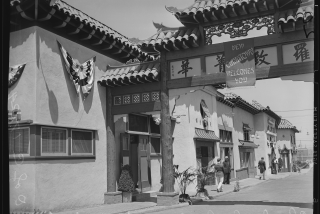A trip down Beijing’s half-fake memory lane
Reporting from Beijing — Our street is full of stories and lies.
The stories come in scraps to the street, one of Beijing’s famous but vanishing old alleyways known as hutongs. The alley’s name, Dajinsi, derives from the golden threads used by the imperial tailors when the street was home to the seamstresses and cloth-dyers of the emperor. Or so the story goes.
The lies, on the other hand, wash up on our doorstep, where imaginative guides stand before sweating bands of tourists to point out the wooden beams and squat stone statues, spinning tales about the previous dwellers: From this we see it was somebody important in the military! This characteristic tells us that here lived a respected academic!
It’s all nonsense, of course. It’s a brand-new house disguised as an old one. The owner leveled the old properties, then layered some traditional touches into the reconstruction: the sloping gray-tile roof, the flowering fruit tree, the courtyard joining one part of the house to the other.
But it’s also got skylights, a finished basement and shiny appliances. When we first moved in, you could smell the newness of the poured concrete and wooden beams.
Still, I don’t interrupt or contradict the guides. I enjoy the stories as much as anybody. I’ll lurk on the other side of the wall and listen until the tourists shuffle down a few doors, where one of our neighbors seems to be doing a brisk business in showing off an honest-to-goodness Chinese courtyard house occupied by authentic Chinese people.
Besides, I figure that if the tourists have their eyes open, they probably get the picture. On the way to our door, they step around piles of fresh lumber, mountains of new brick, listing loads of roofing tiles.
All around us, workers are tearing down the neighborhood and rebuilding it from scratch. My husband and I wake up to the whine of chainsaws, the roar of stonecutters whittling out statues identical to the ones flanking our doors, the groan of bulldozers moving great piles of dirt and rock.
There’s a surreal, surprising beauty to the process. We go around a bend in the road and find a lone kitchen sink standing guard over the wreckage of a home; a facade sheared off, red Chinese New Year posters still clinging to the exposed walls with yellowed tape; a building where before there had been a pile of rubble.
In a way, we are the lucky ones. On the other side of a nearby lake, one of Beijing’s most beloved neighborhoods is getting ripped down, to be replaced with something called the Beijing Time Cultural City.
Preservationists, of course, are outraged. But few ordinary people seem to care.
Most of the tourists who lug their cameras and clamber into rickshaws to tour our neighborhood are, as far as I can tell, Chinese visitors from other provinces. I imagine that, to these tourists, the hutongs occupy the same place as, say, a Colonial Williamsburg, an interesting and abstract glimpse into the way people used to live, but not a desirable everyday lifestyle.
The driver in the Los Angeles Times bureau here shook his head in disbelief when he heard I’d moved into a hutong neighborhood instead of the diplomatic compound. He grew up in the cramped quarters of a shared courtyard dwelling, and escaped as soon as possible. I like apartments, he said. They have modern conveniences.
It’s easy to get melancholy about the disappearance of the hutongs. But I tell myself that this is the face of China. Not the romantic, idealized version, but the more complicated reality of a country whose explosive economic growth is driving what often feels like warp-speed social evolution.
On a balmy Sunday afternoon, we sit under the trees of our courtyard. Kites float in an uncharacteristically clear sky, and the neighbors have released their bands of trained pigeons to circle in the fading golden light. The birds swoop low over our house, stirring the air with their wings, and the colors of sunset glimmer on their bellies.
I savor these minutes, because I know they are fleeting. Like most people in this booming country, the owner of our house is looking for an even better investment. We hear she’s selling the place to a man who wants to create a clothing shop in tribute to those long-dead imperial tailors. We’ll soon have to find another place to live.
The tourists will love the new store.
megan.stack@latimes.com
More to Read
Sign up for The Wild
We’ll help you find the best places to hike, bike and run, as well as the perfect silent spots for meditation and yoga.
You may occasionally receive promotional content from the Los Angeles Times.






